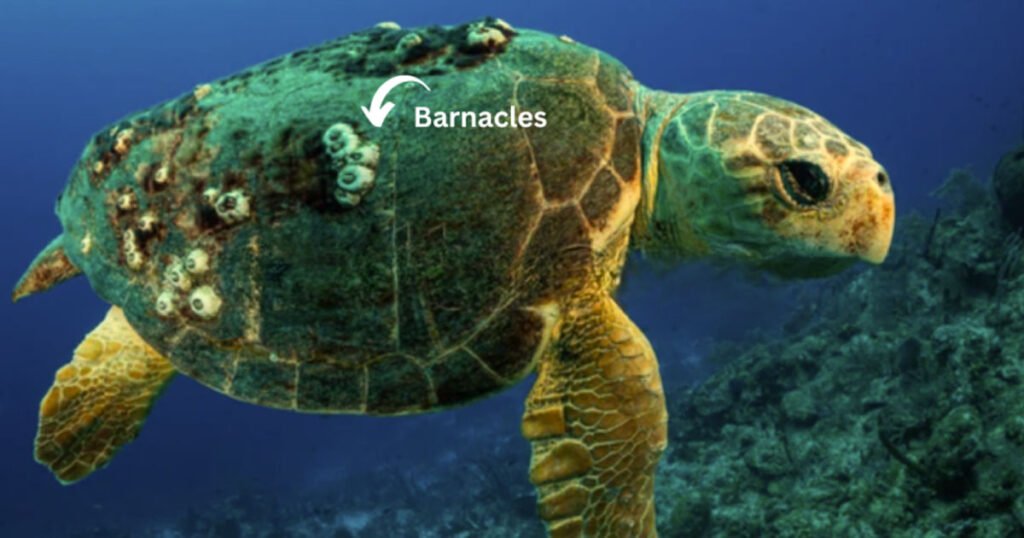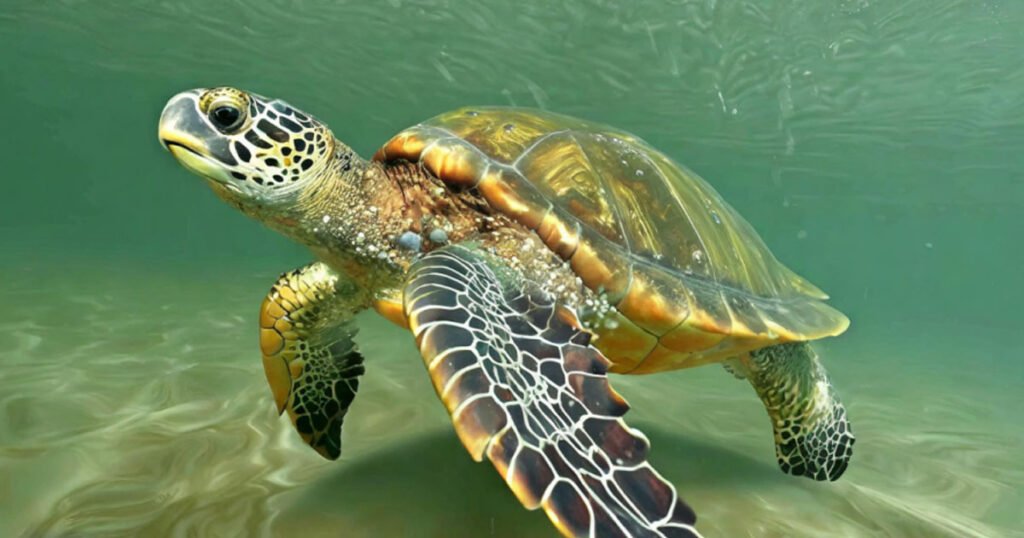Did you ever notice barnacles on a turtle? Barnacles, those tiny little crusties, often ride turtles, attaching to the shell. But do barnacles hurt turtles? That’s the question we’re here to answer. Turtles, those fascinating creatures of the sea, navigate vast ocean waters with their distinctive shells. Yet, these shells can become home to barnacles, leading us to question: do barnacles pose a threat to turtles?
We know turtles live on land and water depending on species compatibility. Do both types of turtles can get barnacles? If you are unfamiliar with barnacles, may not know how they affect which types of turtles. Let’s check out this weird relationship between barnacles and turtles to see if they hurt or harm them.
Table of Contents
What Are Barnacles?

Barnacles are small sticky crustaceans that have a unique lifestyle. They’re usually grayish-white and don’t like it when it’s super cold or dry. They attach themselves to various surfaces, including rocks, ships, and even sea turtles. The Chelonibia genus is the most common barnacle found on turtles. These creatures start their lives as mobile larvae, spreading to new areas before settling down.
Once settled, they use special attachment organs to grip onto their chosen substrate, whether it’s a turtle’s skin or shell. While they may not directly harm turtles, excessive barnacle growth can cause discomfort and other issues. Barnacles can move slightly to find optimal feeding spots despite their stable appearance.
Most of them just hang onto the outside of a turtle’s shell or skin. But some can dig in heavily, which can hurt the turtle and make it easier to get sick or get infections. If a turtle is not healthy enough, it might get a lot of barnacles growing on it. Barnacles are pretty handy at cleaning up as they gobble up debris in the water. They’re part of the Arthropoda group and there are over 1,000 different types of them! You can find barnacles all over the ocean, clinging to rocks and stuff to survive.
Why Are Barnacles Attached To Turtles?
Barnacles are small creatures related to crabs and shrimp, living on hard surfaces like rocks and boat hulls. They live in marine environments due to their ability to filter feed on plankton and debris.
Attachment to Turtles
In their larval stage, barnacles attach to rigid substrates using adhesive secretions, as we mentioned above. Turtles’ hard shells provide a suitable surface for barnacle attachment. The constant water movement around turtles facilitates barnacles’ survival, leading them to latch onto the turtle’s shell.
Lifecycle and Behavior
Barnacles do not move that much once attached to a surface, relying on water currents to bring them food. Sometimes, they use their little legs to grab food from the water. As larvae, they settle on hard surfaces and remain stuck throughout their lives. When turtles swim by, barnacles take advantage of the opportunity to attach themselves to the turtle’s shell.
Barnacles require constant water movement for survival, which is why they settle on any moving substrate. The shell of a swimming turtle provides the ideal environment for barnacles to thrive.
Do Barnacles Hurt Turtles?

While barnacles themselves might not be seen as harmful to turtles, having too many of them can cause problems.
The Weight of Barnacles: A Burden on Turtles
Imagine carrying a heavy backpack everywhere you go—it’d slow you down, right? Well, that’s kind of what it’s like for turtles with too many barnacles on their shells. The extra weight makes it harder for them to move and swim, which can be really tiring and even dangerous.
Impact on Turtle Health: Eyesight and Mobility
Having a bunch of barnacles all over their shells can make turtles struggle to see properly and move around freely. It’s like walking with a bunch of stuff stuck in your shoes—it’s not easy!
The Importance of Monitoring: Ensuring Turtle Well-being
Just like how we go to the doctor for check-ups, it is important to keep an eye on turtles with lots of barnacles. If it looks like they’re struggling, you should step in to help remove the barnacles and make sure the turtles stay healthy. Only if you have an aquatic turtle pet or see sea turtles a lot can you help them.
If turtles have too many barnacles, they can get weak and sick. They might not be able to find enough food to eat or swim properly, which can be really dangerous for them.
Can Turtles Remove Barnacles on Their Own?
When barnacles attach to a turtle’s shell, the turtle may try to remove some of them using its flippers. However, this natural process doesn’t always succeed, especially if the turtle is unhealthy or immobilized due to illness, injury, or cold stunning.
Male vs. Female turtles
While female turtles can sometimes dislodge barnacles during mating, male turtles struggle to remove them. Barnacles may fall off naturally or if the turtle’s shell gets scratched on rocks, but this isn’t always sufficient.
Is It Good To Remove Barnacles From Turtles?
Risks of DIY Removal
If you spot barnacles on a turtle, your instinct might be to help by removing them. But hold on! Trying to pluck them off can do more harm than good. These stubborn crustaceans can dig into the turtle’s skin, making it painful and risky to remove them, especially from soft and vulnerable shell areas. Aside from that, turtles are delicate creatures, and forcing off barnacles can cause serious damage, inside and out. It’s not a DIY job – only trained pros should tackle barnacle removal to ensure the turtle stays safe and healthy.
Safe Removal Needs Professional Assistance
Dealing with barnacles on turtle shells can be challenging due to their sturdy grip. Attempting to remove them without the proper expertise and tools could harm the turtle. It’s essential to seek assistance from trained professionals at wildlife rehabilitation centers. These professionals have the necessary skills to safely remove barnacles without harm.
Legal Considerations and Proper Rehabilitation
Moreover, removing barnacles without permits can lead to legal consequences, as it violates wildlife protection laws. Rehabilitation centers employ careful procedures, including freshwater baths, to facilitate barnacle removal and ensure the turtle’s recovery. With the right care and treatment, turtles typically regain their health and are eventually released back into their natural habitat.
What Is the Easy Way To Remove Barnacles From Turtles?
When barnacles attach to a turtle (a few like one or two), they don’t cause direct harm. They might affect the turtle’s swimming efficiency and add some weight, but they don’t cause pain.
If a sea turtle is sick and heavily infested with barnacles, a day in a freshwater tank can help. The high salt content in barnacle tissues makes them sensitive to freshwater, causing them to die and fall off. This method ensures that the turtle remains unharmed while effectively removing the barnacles. It’s a natural and non-invasive way to help sick sea turtles.
Do Barnacles Hurt Sea Turtles?
Typically, no, a few barnacles, won’t hurt sea turtles. However, if a turtle’s shell is heavily covered with barnacles, it can become quite heavy, causing the turtle to feel weighed down. This added weight can make it challenging for the turtle to swim and move effectively, potentially leading to discomfort and other health issues.
Do Barnacles Hurt the Shell of a Turtle?
Barnacles typically don’t hurt the shell of a turtle if there are only a few of them. However, when there’s a heavy infestation, with numerous barnacles covering the shell, it can cause damage. The weight of the barnacles adds extra pressure on the turtle’s shell, which may lead to discomfort and other issues.
Do Barnacles Hurt Turtles’ Shells?
Naturally, barnacles do not hurt turtles’ shells, if they are few and not living so long on the shell. If the number is a lot, and they are stuck on the shell for a long time they can affect the inside body of a turtle.
Read More: Do Turtles Have Scales: Everything You Need To Know
Bottom Line
When it comes to the question “Do barnacles hurt turtles?” the answer isn’t always straightforward. While a few barnacles may not pose a significant threat, a heavy infestation can indeed cause harm. These stubborn crustaceans, while seemingly innocuous, can burden the turtle’s shell, affecting its mobility and overall health.
Therefore, it’s crucial to monitor barnacle growth on turtles and take appropriate action when necessary if you encounter it. So, let’s continue to protect our ocean friends and ensure they are healthy in their natural habitat.
